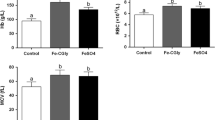Abstract
THE discovery of sex-linked anaemia in the descendants of an irradiated mouse was followed by further evidence and the suggestion2 that there was a hereditary defect in intestinal iron absorption in these animals. Our studies on everted gut sacs in vitro provide the first direct evidence of a selective genetic defect in the second or serosal transfer step3 of the active transport mechanism for iron in the duodenum of the sex-linked anaemic (sla) mouse.
Similar content being viewed by others
References
Falconer, D. S., and Isaacson, J. H., Genet. Res. Camb., 3, 248 (1962).
Pinkerton, P. H., and Bannerman, R. M., Nature, 216, 482 (1967).
Manis, J. G., and Schachter, D., Amer. J. Physiol., 203, 73 (1962).
Biology of the Laboratory Mouse (edit. by Green, E. L.), second ed., 352 (McGraw-Hill, New York).
Manis, J. G., and Schachter, D., Amer. J. Physiol., 203, 81 (1962).
Author information
Authors and Affiliations
Rights and permissions
About this article
Cite this article
MANIS, J. Active Transport of Iron by Intestine: Selective Genetic Defect in the Mouse. Nature 227, 385–386 (1970). https://doi.org/10.1038/227385a0
Received:
Issue Date:
DOI: https://doi.org/10.1038/227385a0
- Springer Nature Limited





